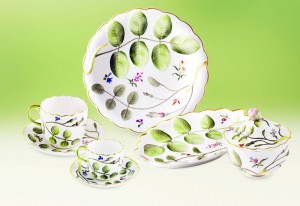With Spring finally in full swing, we thought we’d share this story about Blind Earl china.
I close my eyes and rub my fingers all around these Royal Worcester “Blind Earl” pieces. While we can’t always see history, antiques allow us the opportunity to feel our past. The tactile experience of handling antiques often evokes emotions that are inaccessible to us if we simply see the object. Holding great granny’s mixing bowls transports us to her kitchen. Right now, with this act of touching, I am transported to the English countryside in 1750, with me is an Earl who is also experiencing this china through touch.
We don’t know much about George William Coventry, the fifth Earl of Coventry (1722-1809), for whom this china was named. The Coventry family descends from John Coventry who, in 1436, served as Lord Mayor of London. The Earl post was opened two times. First for George Villiers in 1623 and second for thomas Coventry in 1697. George William became the fifth earl in 1750; he was also the Lord Lieutenant of Worcestershire. In 1780, George William suffered from a hunting accident and lost his sight completely. This accident altered history’s perception of George William and he has since been known as the ‘blind earl.’
Acting as the Lieutenant of Worcestershire, after his accident George William commissioned the newly-founded china company from that same area, Royal Worcester, to design a raised and textured china pattern that he could feel. Royal Worcester was a most illustrious china manufacturer because it had developed heat-resistant china, making it possible to serve tea in porcelain teapots. Royal Worcester had discovered that adding soapstone to porcelain prevented the material from shattering. The company had fourteen shareholders, all of whom agreed to pay a hefty fine if they ever shared the production secret. Royal Worcester was the most important china company in England at the time, and it received many royal commissions. To have a full dinner set in this pattern was a mark of great taste and stature. The Blind Earl pattern is an example of the fine workmanship for which Royal Worcester is famous. The textured floral motif looks like the English countryside.
In spite of the irresistible romance of this story, some historians disagree with its timeline. Royal Worcester first produced their blind earl china in the 1750’s, and George William’s accident reportedly occurred in 1780. One alternative story, for example, suggests that there were two generations on blindness in the Coventry family. Speculatively, this could mean that the hunting accident has been fabricated and that the blindness was a degenerative hereditary condition.
Speculating on the truth of the story is part of the appeal of Blind Earl. This pattern offers antique lovers and history buffs a glimpse of the British high society in general and of one Earl in particular. To feel this china is to participate in its history.
For more beautiful antiques, check out our site.





5 Comments